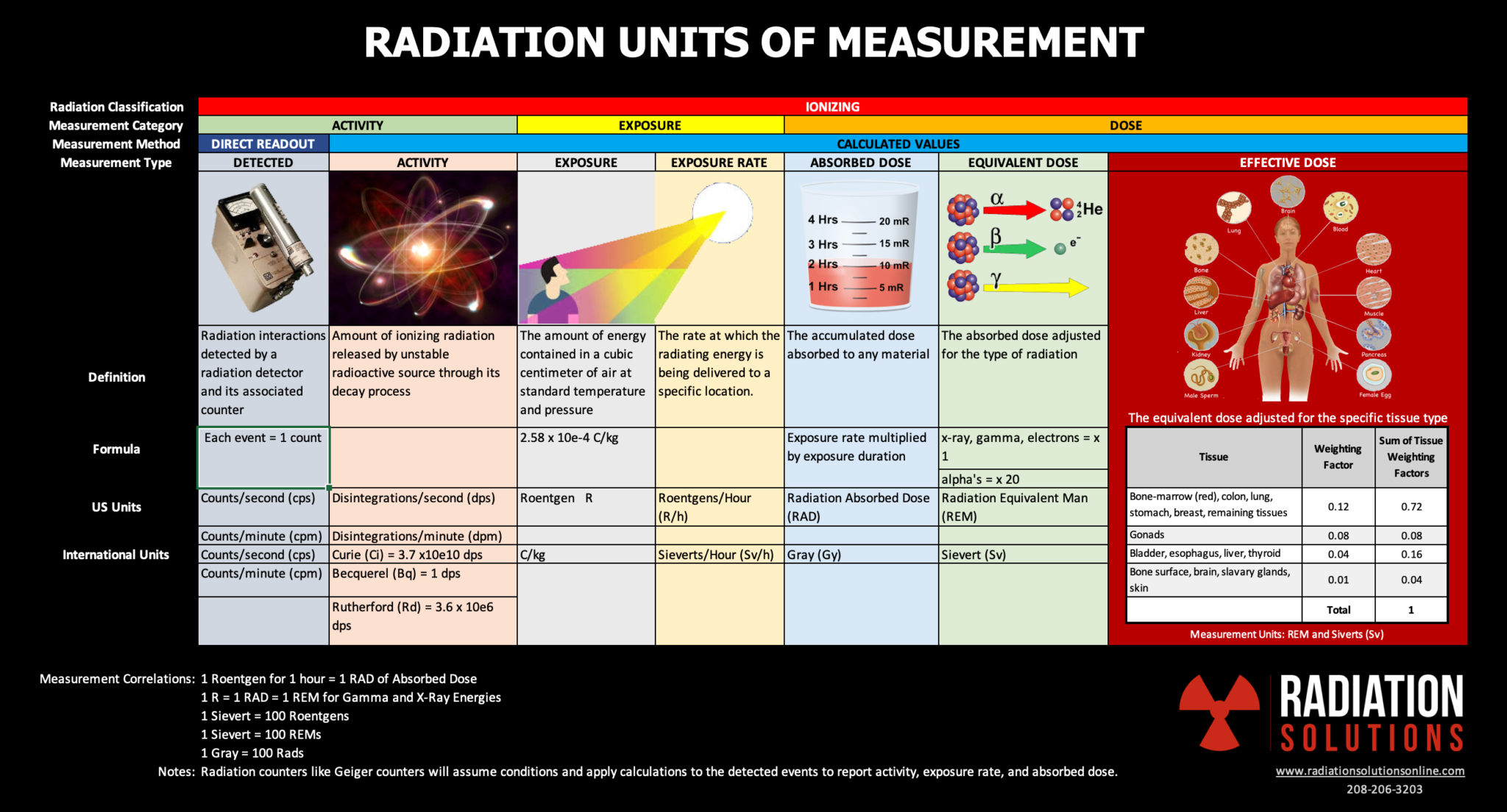Why are Radiation Measurement Units So Confusing?
To radiation neophytes, the subject of radiation measurement units can be a confusing topic. All too often this topic is explained by taking you through complex set of physics, energy conversions, and mathematical formulas that only make this subject even more esoteric and confusing.

The confusion is not merely a function of physics and mathematics but is also be attributed to the evolving science and history of this subject. Ever since Willhelm Roentgen first discovered X-rays in 1895 and the Roentgen unit was first established in 1902, the science has continued to evolve with refined definitions and added measurement units. This refinement continues even today as we become more and more knowledgeable and continue our quest for absolute measurement certainty.
A second component of confusion is the duality of units with the US and the International community. This is not any different than many other forms of measurement. The International Commission of Radiation Units (ICRU) has established a set of standards to bring about world-wide uniformity, but here in the US, we cling on to past units and definitions as far as we can. Overcoming past traditions, the huge number of perfectly functioning rad meters utilizing older measurement units that are still in use, and perhaps some of the American Revolutionary Independency all contribute to the US slow uptake to the newer measurement standards.
A third element adding to the confusion is the fact that most measurement units are not actually directly measurable. What you say? Yes, this means that many of the radiation measurement types are calculated values derived only after radiation detection events are collected by a rad meter. For example, you cannot detect the REM or Sieverts of dose received by the lens of an eye; it has to be calculated based upon a number of factors once the radiation measurement by a rad meter like a Geiger counter has been made.
Added to this is a sub-level of added confusion whereby manufacturers of such instruments have purposefully ignored measurement technicalities in an effort to simplify radiation understanding for non-scientific users, extend the applications of a given instrument configuration, and indirectly sell more instruments. To measurement purists, this is almost inexcusable, but tradition, economics, ignorance, and simplicity remain a formidable force yet to be overcome.
Comprehending all these factors and correctly applying all the physics and accompanying formulas are what Health Physicists are educated and trained to do. But for the rest of us who do not have four or more years of study on this subject, there has to be a simpler way. This article attempts to expose you (pun intended) to all the nuances in one simple elegant way.
Radiation Fundamentals
Here are a few fundamentals you need to understand before moving on. You may wish to also read our blog entitled: What is Radiation to gain a quick and better understanding as well.
Understanding Measurement Types
Like any other physical property, it can be measured in multiple ways. Radiation is similar and can be broken down by classification, category, method, and type. The chart in Figure 1 below provides a convenient overview that shows how these radiation measurement units all fit in relationship to each other. It’s quite a broad view, but I believe it gives a beginner a full perspective or map that places everything in their proper order and relationship. This map in combination with the explanations that follow should provide you with an adequate foundation.
The Three Basic Categories of Ionizing Radiation
Activity
Activity measures the energy being emitted from unstable atoms until they reach equilibrium like other non-radioactive elements. The activity levels vary by the type of radionuclide and the amount of material present. The activity level is an important measurement to assess the amount of radioactive material being sold or just found. It’s also the key measurement for any contamination that might be found or is present on persons, objects or the surrounding area. Finally, it’s used to see if the activity level requires immediate corrective action to ensure safety of all involved.
Exposure
Over exposure to harmful rays is no good independent of whether you’re talking sun rays, x-rays, or gamma rays. So knowing your exposure to these radiations anytime you enter into an environment with either known or unknown ionizing radiation is key to any radiation safety program. Exposure type measurements determine the rate at which irradiation is impacting you. The purpose of these measurements is to ensure work areas are below regulatory limits so accumulative doses are never exceeded. When working in higher exposure rate areas, it also establishes how long one can safely remain in the radiation field before having to leave.
Dose
The harmful effects of radiation exposure are pretty well known and are ultimately attributed to radiation dose values. Bombardment by higher energy, ionizing radiation over elapsed time causes fundamental changes to a materials structure. When the material is living tissue, it can damage or even kill it if over-exposed. Regulations are all keyed to annual dosage limits that have large built-in safety factors.
Radiation dose is not uniform across all radiation types and materials. Radiation dosage effects vary depending upon the radiation type and the material receiving the dose so they must be measured and noted separately.
All doses are initially calculated by taking the exposure rate in air (which is all that radiation detectors can really measure), and multiplying it by the exposure time to arrive at a general-purpose dose value called Absorbed Dose. In living tissue, not all radiations are equivalent; alpha producing radiations, for example, contribute 20 times more dose damage than gamma and x-rays. So, multiplying your Absorbed Dose by 20 then gives you an appropriate Equivalent Dose. Absorbed Dose effects on living tissue also varies by tissue type, so applying an appropriate dose factor for each type of tissue is required to arrive at what is known as the Effective Dose.
The Two Methods of Measuring Ionizing Radiation
Given all the measurement types and categories, it may be somewhat surprising that there really are only two measurement methods: Direct Measurement and Calculated. It may also be surprising that the majority of measurement types all fall into the latter category. I suspect most incorrectly believe that rad meter direct measurements tell the whole story and once you know how to read a rad meter, you’re good to go. But fundamentally, that simply is not so, it’s just the beginning. Here’s why….
Direct Measurement

Direct Measurement is the method whereby one acquires a radiation reading “DIRECTLY” from a radiation meter. For simplicity sake, I am going to restrict the foregoing explanation to simple Geiger counters that are dominantly used throughout industry.
All radiation meters function basically the same in that they electronically view the interaction of radiation within the detector medium and count the separate interactions. There are several types of detector sensing materials each with their own set of unique characteristics. As such, not all radiation detectors are equal; each will have their sensitivities, advantages, and disadvantages.
Rad meters are inherently radiation unit agnostic, in that they natively can only report the number of interactions counted within their small detector volume per unit of time. That’s all they see and know. Thus natively, they can only report the raw counts per minute or raw counts per second. They have no idea what type of radiation they are counting, the energy level, isotope, the originating source activity, nor how far away or what direction the source is. In other words, all the details you really want to measure cannot be inherently be obtained without additional knowledge. Hence beyond raw counts, all radiation measurements need to be calculated.
Calculated

Having established that gross counting radiation meters fundamentally only acquire relative count values based upon their inherent interaction characteristics, we recognize that in order to obtain meaningful radiation measurements more intelligence needs to be factored in.
The factors required will be different for each type of measurement type but always begin with the known detection characteristics of the specific detector used, the overall system detection efficiency, time of measurement, exposure level and time, and where possible the radiation isotope, energy, and distance to the source.
For Geiger counters that display readings beyond other than just counts, which most do, many of these factors have to be assumed. The most common assumption is that the energy is close to Cs-137 gamma energy of 660 keV.
Radiation Measurement Units Definitions
Fractional Units of Measurement Often Necessary

Many of the base radiation measurement units described above represent very large amounts of radiation. It therefore becomes necessary quite often to describe these in fractional terms or scientific formats as presented in the table below.
Practical Radiation Measurement Values
Here are some measurement values to better understand the environment we live in and the dose impact to our bodies:
Backgrounds
Average background exposure rates: 10 uR/h (0.1 uSv/h)
Daily dose (using exposure rates above): 240 urem (2.4 uSv)
Yearly dose (using exposure rates above): 88 mrem (0.88 mSv)
Flying
Transatlantic Airplane Flight: 7 mrem (0.07 mSv)
European Airline Crew Annual Limit: 2 rem (20 mSv)
6 month flight on Int. Space Station: 7.5 rem (75 mSv)
180 days transit to Mars: 13.3 rem (133 mSv)
Medical
Chest X-ray: 6 mrem (0.06 mSv)
Panoramic Dental X-ray: 9 mrem (.09 mSv)
Mammogram: 70 mrem (0.7 mSv)
Full Body CT Scan 1 rem (10 mSv)
Regulatory
Annual Public Dose Limit: 100 mrem (1 mSv)
US Annual Rad Worker Occupational Dose Limit: 5 rem (50 mSv)

Body Effects
Radiation Effects when doses occur in short period:
- Dose causing symptoms: 40 mrem (0.4 Sv)
- Letha Dose (50% death): 400 rem ( 4 Sv)
- Certain death: 800 rem ( 8 Sv)
Conclusion
Believe it or not we have hardly scratched the surface when it comes to radiation measurement units. The chart in Figure 1 should prove helpful anytime you need to cross reference units and standards, or better understand what type of dose is being measured or referenced. If you’re interested in an even simpler explanation, see our other blog Watered-Down Perspective to Radiation Measurement Units.
Radiation measurement becomes very exciting when you have a Geiger meter in hand and have different radio-isotopes available for lab experimentation. Watching the meter behavior to invisible rays and particles streaming from different isotopes, source activities, and varying distances can be a lot of fun and put you in touch with the invisible realm of radiation and its ability to be measured. When measuring contamination, or calculating doses for given exposure rates you also get a better understanding of the different dose types and how they relate to the activities you counted with your rad meter.
Radiation Measurement Units make a lot of sense once you take just a little time to grasp it. Like any other measurement units, there’s a lot of history and science behind them, but we need not understand all of that to benefit from the measurements.

